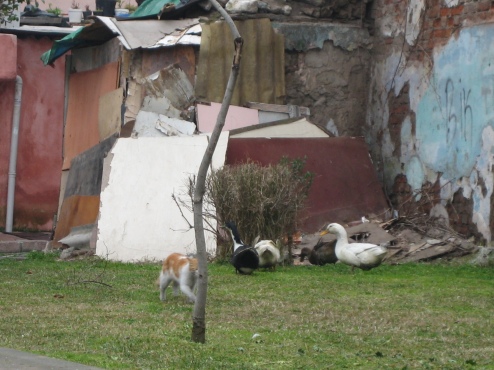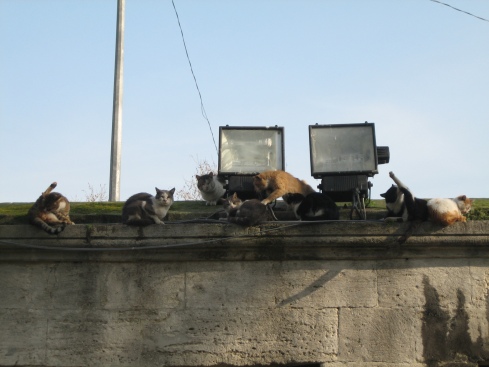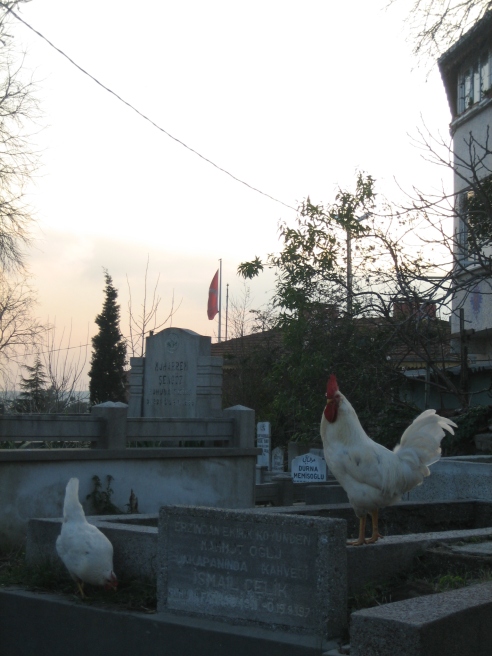Particular cities seem extraordinarily sensitive to domesticated dogs as companions and pets. In these cities (think of Toronto or San Francisco), domesticated dogs have access to spas, day cares, and therapists; pet-inclusive evacuation legislation; and public transportation rides without a cage or leash. Other cities, such as Istanbul and Sofia, are attuned to another reality: that of domesticated dogs and cats as “beasts in their own right,”‡ or urban free-rangers.
Welcome to Urban Animal Geography.
Pets and Companions: Intimate Encounters
In Toronto, dogs accompanied by their owners can ride streetcars, metros, and buses. Dogs can also count on Torontonian café owners to place drinking bowls and leash stands near café entrances.
In San Francisco, sea lions live at Pier 39 and dogs rule (well, maybe not, but according to a recent New York Times article, dogs outnumber school children). In parks and on beaches, the dog guardian commits wholeheartedly to the dog’s ball playing and beach running. Time is reserved and places are occupied for intense animal-human leisure. When SF dog owners speak to their dogs, you might think they are speaking with their sons and daughters, Jeremys and Jasmines. The humans interact with dogs as companions, friends, and family members, not as beasts per se. It’s fascinating to watch and listen. I assure you.


Urban Free-Ranging Animals: Strays and Street Dwellers
In Istanbul, urban free-ranging dogs run in packs, eat scraps and food left by human neighbours, and sit together on grassy knolls overlooking the city. Some find nooks to rest in and return to them every day. Others lie injured or asleep on sidewalks. None intimated me, or others it seems, and all retained their beastly nature.

Their contemporaries, urban free-ranging cats, hang out by mosques, markets, and shops, where they receive daily doses of caresses and hugs, food and nutrition. Unlike the dogs we observed, the cats cat-fight.
Neither feral nor members of human families, the free-ranging dogs and cats of Istanbul are urban actors in their own right.



Sofia also has a large population of stray dogs. Last month, at least a dozen of the city’s 10,000 strays attacked a man. Since, the national minister of agriculture tried to establish new control measures, including euthanasia, arguing that aggressive strays don’t belong in the city and that residents who feed strays should be fined. Residents and animal activists protested in the streets, and the government backed away from euthanasia-as-solution.
In Delhi, cowboys rope urban cattle in the city’s effort to rid streets of urban free-ranging cows. In 2002, residents petitioned the city to deal with Delhi’s approximately 20,000 stray urban cattle. The cowboys bring the cows to shelters, where they are darted with microchips and sent to live in cattle “sanctuaries.” Not all of the city’s residents support this population movement; some actively contest cattle captures by throwing stones at the cowboys.
Animal Mobility: A Montreal Story
Believe me when I say that Montreal dogs and cats don’t roam nearly as much or as far as their canine and cattle counterparts in Istanbul, Sofia, and Delhi do. And I’ve been told by pet-owning friends that Montreal isn’t as pet-friendly as Toronto, San Francisco, or other North American cities. I know, from a recent apartment hunting experience, that landlords discriminate against potential tenants with dogs and cats. It isn’t easy being renter and pet keeper in Montreal, after all.
And what if you’re also a public transit user? Well, excepting guide dogs, all pets too big or heavy to fit in a cage are excluded from the transit system. This is a far cry from the debate in Toronto about whether dogs should sit on metro seats!
A friend of mine started a Facebook group—Pour les chiens dans le métro montréalais/Yes to Dogs in the Montreal Metro—to campaign against what he and other Montreal dog owners see as their limited mobility. The group argues that dogs’ access to transit would make possible visits to family, friends, and veterinary clinics that are otherwise too far to walk to or too expensive to cab to. (If you have the means, PetTaxi will accompany your pets to their appointments. No pet owner required.)
Unlike its domesticated dogs, Montreal’s domesticated pigeons fly freely. They also defecate frequently on the city’s stone landmarks (the Norman Bethune statue near Concordia University is a classic pigeon haunt). A few years ago, I met an art history grad student who studied pigeon tracks in wet cement and animal-human interactions on the sidewalk. Her interventions included filling tracks with green gelatin to bring them to humans’ attention and blogging directions for a “self-guided walking tour of pigeon footprints in the sidewalks around Concordia University.”

Just another urban animal geography.
I’d like to hear from you. How do animals and humans interact in your city? Are dogs leashed, feared, or collectively cared for? Share your cattle tattle here.
In Amsterdam dogs are allowed on the Tramways and can lay at your feet in restaurants. Not something that we see in Ottawa. However, on the sidewalks, you have to watch where you step, as some pet owners are not very responsible.
This is great to know! I think animals on public transit might still be a relatively uncommon occurrence (I mean, globally ). Were they leashed? I think leashes are less common in France and maybe in Netherlands, too. I might be generalizing … :)